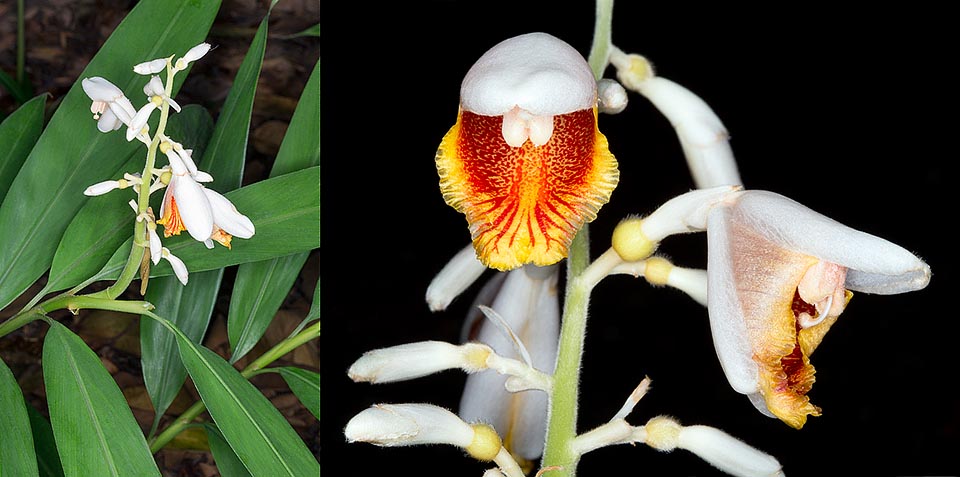Family : Zingiberaceae

Text © Pietro Puccio

English translation by Mario Beltramini
The species is native to Borneo, Java, India, Myanmar, Peninsular Malaysia, Singapore, Sulawesi, Thailand and Vietnam where it lives in the humid forests on swampy soils close to water streams.
The genus is honoured to the Italian physician and botanist Prospero Alpini (1553-1617); the specific name is the Latin adjective “muticus, a, um” = cut off, bevelled.
Common names: dwarf cardamon, false cardamon, forest kerapat, narrow-leaved alpinia, orchid ginger, small shell ginger, small shellflower (English); kerapat bai, seki pui bai (Indonesia); chengkenam (Malaysia).
The Alpinia mutica Roxb. (1810) is a perennial rhizomatose herbaceous species, evergreen, forming dense 1,5-2 m tall tufts. Thin pseudo-stems provided of leaves, on a 0,5-1 cm long petiole, alternate, linear-lanceolate with long pointed apex, 28-50 cm long and 3-6 cm broad, coriaceous, of glossy intense green colour; the crushed leaves emit a smell similar to the green cardamom (Elettaria cardamomum (L.) Maton). Terminal panicle inflorescence, erect, pubescent, 12-15 cm long, bearing numerous drooping hermaphroditic flowers, singly of one day duration, opening gradually, in groups of 2-3, for 30-45 days; the flowers are self-sterile, therefore they need a crossed pollination for the fructification. Pubescent tubular calyx, 1,5-2 cm long, of white colour wirth reddish tridentate margin, white corolla with tube shorter than the calyx and 2,5-3 cm long lobes, the ovate dorsal, concave, 1,5 cm broad, the oblong lateral, 0,6 cm broad, ovate labellum almost trilobed, 3,5 cm long and 4 cm broad, of intense yellow colour veined and dotted of red, only one fertile stamen with two lodges, as long as the corolla, and white-cream anthers.

Native to South-East Asia, the Alpinia mutica is a perennial herbaceous species forming dense tufts even 2 m tall. Great ornamental value and medicinal virtues © G. Mazza
The fruits are ovoid orange red capsules, about 2,2 cm long and of 2 cm of diameter, persistent long on the plant, containing numerous seeds that at times germinate still attached to the mother plant. It reproduces by seed, previously kept in warm water for two days, in organic draining loam at the temperature of 22-24 °C, but usually and easily by division of the rhizomes.
Species of considerable ornamental and landscaping value, for the foliage as well as for the inflorescences, cultivable in the tropical and humid subtropical climate regions, where it is blooming for most of the year, and marginally in the temperate-warm ones, where temperatures around the 0 °C are a short lasting exception.
It requires an exposition in full sun or slight shade and well drained soils rich of organic substance, slightly acidic to slightly alkaline, maintained constantly humid, but without stagnations. Where the climate does not allow the continuous permanence in open air it may be cultivated in capacious containers to be sheltered in a very luminous ambient in the coldest months; useful are the fertilizations with balanced products, with microelements, from spring to autumn.
The rhizome and the medulla of the young stems are utilized in the traditional medicine for various pathologies.
Synonyms: Renealmia mutica (Roxb.) Salisb. (1812); Alpinia laxiflora Gagnep. (1902); Alpinia korthalsii K.Schum. (1904); Languas korthalsii (K.Schum.) Merr. (1929); Languas laxiflora (Gagnep.) Merr. (1929); Languas mutica (Roxb.) Merr. (1929); Catimbium muticum (Roxb.) Holttum (1950).
